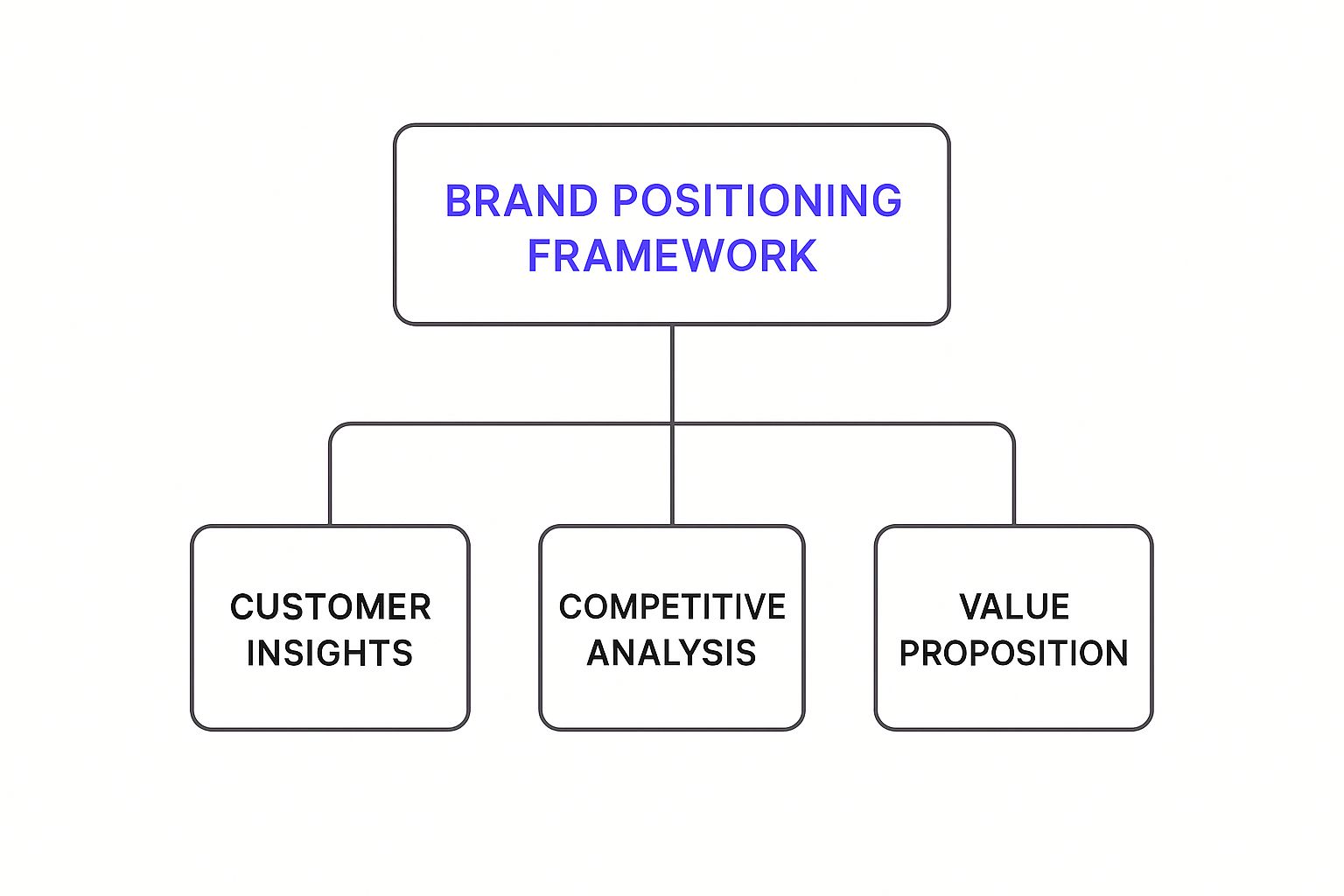Build a Powerful Brand Positioning Framework

Think of a brand positioning framework as the North Star for your business. It’s the single, strategic document that clearly defines your unique place in the market and, more importantly, in the minds of your customers. This isn't just fluffy marketing-speak; it's the architectural blueprint that guides every single decision you make, ensuring every ad, product launch, and customer service email reinforces the same powerful story.
Your Brand’s Blueprint for Success

Imagine trying to build a skyscraper without a detailed plan. You could hire the best construction crew and buy the finest materials, but the project would be pure chaos. The foundation might be shaky, the floors misaligned, and the final structure would almost certainly be a failure.
That’s exactly what it’s like to build a brand without a positioning framework. You can pour money into ads, create stunning content, and develop game-changing products, but without that core strategy, your efforts will feel disconnected. Your message gets lost in the noise, and customers are left wondering what makes you any different from the competition.
A brand positioning framework is that essential blueprint. It forces you to answer the most fundamental question in business: "Why should a customer choose us over everyone else?"
The Core Purpose of a Framework
At its heart, this framework is all about achieving two things: clarity and consistency. It’s an exercise in making deliberate choices about who you are as a brand, who you're here to serve, and what unique value you bring to the table. Once you define this, you have a guiding light for your entire business.
Your brand positioning framework is the art of staking out a piece of mental real estate in your customer's mind. It ensures that when they think of a solution to their problem, they think of you first.
This strategic clarity isn’t just a nice-to-have; it delivers real business results. A well-defined position helps you:
- Cut Through Market Noise: In a crowded industry, a distinct position makes your brand memorable. It gives people something to latch onto.
- Guide Strategic Decisions: From product development to the scripts your customer service team uses, the framework ensures every touchpoint reinforces your core message.
- Build Lasting Brand Equity: Consistency builds trust. In fact, research shows that brands with a consistent presentation can see their revenue increase by up to 33%.
- Attract and Retain the Right Customers: A clear position acts like a magnet for customers who share your values, leading to greater loyalty and turning customers into advocates.
This guide will walk you through exactly how to build and apply this powerful tool. This isn't just theory—it’s the foundational work that separates fleeting brands from the ones that become truly iconic.
To really get what a brand positioning framework can do for you, it helps to look at where it came from. And its origins might surprise you. This isn't some hot new marketing fad cooked up in a Silicon Valley conference room. It's a strategic discipline that’s been shaping legendary brands for over a century. The core ideas were being put to work long before anyone came up with a fancy name for them.
Our story starts in the early 20th century, back when advertising was just finding its footing. Agencies were starting to realize they could do more than just announce a product's existence; they could give it a soul. They were figuring out how to build a brand personality—a unique identity that could capture a customer's imagination.

The Pioneers of Perception
Way before the term was officially coined in the 1960s, a few forward-thinking ad agencies were already masters of the craft. Take the J. Walter Thompson agency, for example. As early as the 1920s, they were applying positioning concepts without calling them that.
Their work with Lux soap is a classic case. They transformed it from a basic, functional soap for washing woolens into a symbol of luxury and glamour by tying it to movie stars and high fashion. It was a brilliant, deliberate move to own a very specific, desirable spot in the customer's mind. That’s positioning in a nutshell.
This pivot from function to feeling laid the foundation for everything that followed. It proved that a product wasn't just about what it did, but what it meant to people. That’s a lesson that’s just as critical today when you’re figuring out how to attract clients.
The Modern Definition Emerges
It wasn't until the 1960s and 70s that these scattered practices were finally given a name and a formal structure. Marketing strategists Al Ries and Jack Trout changed the game with a series of groundbreaking articles, which later became their iconic book, "Positioning: The Battle for Your Mind."
Ries and Trout argued that positioning isn't about what you do to a product. It's about what you do to the mind of the prospect. In a world drowning in advertising, the only way to cut through the noise is to secure a clear, narrow position in your customer’s head.
They laid out a few core ideas that are still the bedrock of any solid brand positioning framework:
- Be First: It's always better to be the first brand that comes to mind than the first one to hit the market.
- Find a Hole: If you can't be first, find an empty space—a "hole" in the market—and own it.
- Reposition the Competition: To carve out your own space, you sometimes have to shift how people think about the market leader.
This little history lesson is more than just trivia. It shows that a brand positioning framework isn't just a tactic; it’s a time-tested strategic imperative. It's a discipline rooted in a deep understanding of psychology and market dynamics, proven to build brands that don’t just survive, but thrive for generations. Knowing this backstory gives you a much deeper appreciation for the framework you're about to build.
Deconstructing the Brand Positioning Framework
Think of a brand positioning framework not as some rigid, corporate document, but as a sophisticated machine built from a few key, interconnected parts. To really get it, we need to pop the hood and see how each component works together to create a brand that feels cohesive and compelling. Each piece answers a fundamental question about your business, and when you put them all together, they form an unshakeable foundation for your marketing.
At its heart, a strong positioning framework comes from a deep understanding of your business landscape. This visual breaks down the three core inputs you need to get started.

As you can see, great positioning happens at the intersection of three things: knowing your customer inside and out, knowing who you're up against, and being crystal clear about what makes you different. Once you have these inputs, you can start building the four pillars of your framework.
The Four Pillars of Brand Positioning
These pillars aren’t just abstract concepts. They are the practical, actionable elements that will steer your entire strategy. Let's break them down one by one.
1. Target Audience
This is the "who." It’s a laser-focused definition of the specific group of people you exist to serve. One of the biggest mistakes brands make is casting the net too wide, trying to be everything to everyone. Strong positioning does the exact opposite—it picks a tribe.
Instead of saying your audience is "small business owners," a powerful positioning statement might say it's "first-time e-commerce founders in the artisan food space." That level of specificity is a superpower. It lets you craft messages that resonate on a much deeper level because you're speaking directly to a real person's challenges and dreams.
2. Market Category
This is the "where." It defines the competitive arena you're playing in. Essentially, it's the frame of reference customers will use to understand what you are. Are you a luxury sedan, an affordable EV, or a rugged off-road truck?
Defining your market category helps set customer expectations from the get-go. It tells them who to compare you against and establishes the baseline for price, features, and quality you need to either meet or beat.
A well-defined market category acts as a mental shortcut for consumers. It instantly tells them where you fit in their world and who your direct competitors are.
This is a strategic choice. You can either compete head-on in an established category or create an entirely new one, like when HubSpot pioneered the "inbound marketing platform" space.
3. Brand Promise
This is your "what." It's the single most compelling benefit you deliver to your target audience. This isn't just a laundry list of features; it's the one unique thing that solves their biggest problem or fulfills their deepest desire better than anyone else.
For example, Volvo's promise isn't "we have side-impact airbags and reinforced steel frames." Their promise is safety. Every feature they build is just proof that backs up that single, powerful idea. A clear brand promise is simple, memorable, and easy for customers to get behind.
4. Reasons to Believe
Finally, this is the "why." These are the tangible, factual proof points that give your brand promise credibility. Without proof, your promise is just an empty slogan. Your Reasons to Believe are the evidence that builds trust and helps you overcome any skepticism.
This pillar is absolutely critical for protecting your brand's integrity. If your reputation takes a hit, your reasons to believe crumble. This is why effective social media reputation management is so important—it ensures your proof points stay believable and your audience continues to trust your brand promise.
To bring it all together, here's a quick summary of the four pillars that form a complete brand positioning framework.
The Four Pillars of Brand Positioning
This table breaks down the essential elements you need to build a comprehensive brand positioning framework and explains the role each component plays.
| Pillar | What It Defines | Key Question to Answer |
|---|---|---|
| Target Audience | The specific group of people your brand is for. | Who are we trying to connect with? |
| Market Category | The competitive landscape your brand operates within. | What business are we really in? |
| Brand Promise | The unique value or benefit your brand delivers. | What is the #1 thing we want to be known for? |
| Reasons to Believe | The evidence that supports your brand promise. | Why should anyone believe our claim? |
Think of this table as your checklist. By answering each of these questions thoughtfully, you'll have everything you need to build a positioning framework that gives your brand a true competitive edge.
How to Build Your Brand Positioning Framework

Alright, you get the theory. Now it's time to roll up our sleeves and put it into practice. Building your brand positioning framework isn't some abstract marketing exercise—it's a deliberate process of discovery, analysis, and strategic choice.
Think of yourself as an engineer assembling a high-performance engine. Every single component needs to be perfectly calibrated and fitted together for the whole thing to run smoothly. This guide will walk you through that assembly process, step by step, turning big ideas into a concrete strategy that gives your brand a clear, defensible spot in the market. Let’s get building.
Step 1: Analyze the Market and Your Competition
You can't win a game if you don't know the players or the rules. So, the first move is always to zoom out and get a clear lay of the land. This means looking at two things: the broader market dynamics and the specific competitors you're up against.
Good positioning is built on a solid foundation of research. You need to dig into consumer needs, current behaviors, and what your competitors are up to. This is where you'll find the openings—the gaps in the market your brand can fill.
Start by creating a map of your competitive landscape. For every key competitor, you need to analyze:
- Their Positioning: What's the promise they're making to their customers? What mental real estate are they trying to own?
- Their Audience: Who are they really talking to? Look at their messaging, their ads, and their product features.
- Their Strengths & Weaknesses: Where do they shine, and more importantly, where do they stumble? Their weakness is often your biggest opportunity.
This isn't about mimicry. It's about intelligence gathering. The whole point is to find the unoccupied territory where your brand can plant its flag and thrive.
Step 2: Define Your Target Audience Persona
Once you understand the competitive field, you need to know exactly who you're trying to reach. A fuzzy description like "millennial entrepreneurs" just won't cut it. You have to get granular.
This is where a target audience persona comes in. It’s a detailed, semi-fictional profile of your ideal customer, pieced together from real data and research. Give them a name. A job. What are their goals? What keeps them up at night? The more real this person feels to you, the better.
A well-crafted persona transforms your target audience from a faceless demographic into a relatable human being. This empathy is the key to creating messaging that truly connects and resonates on an emotional level.
This deep understanding of your audience will guide every decision you make from here on out. It ensures your brand’s promise and voice are perfectly tuned to their world.
Step 3: Craft Your Brand Positioning Statement
This is the moment it all comes together. All your research, analysis, and insights get distilled into a single, powerful declaration. Your brand positioning statement is an internal document—think of it as your brand's North Star. It guides every external marketing message, every piece of copy, and every campaign you run.
A classic, battle-tested formula for this statement looks like this:
For [Target Audience], [Your Brand] is the one [Market Category] that delivers [Brand Promise] because only [Your Brand] has [Reasons to Believe].
Let's break that down with a quick example for a hypothetical project management tool:
- Target Audience: Freelance graphic designers juggling multiple clients.
- Market Category: Project management software.
- Brand Promise: Effortless visual project tracking that simplifies client feedback.
- Reasons to Believe: An intuitive drag-and-drop interface, integrated client annotation tools, and automated deadline reminders.
Put it all together, and you get: "For freelance graphic designers juggling multiple clients, VisuFlow is the one project management software that delivers effortless visual project tracking, because only VisuFlow has an intuitive drag-and-drop interface with integrated client annotation tools and automated deadline reminders."
See how that works? It's specific, defensible, and laser-focused. It leaves no doubt about who the brand is for, what it does, and why it's the best option. This statement is the most critical piece of the puzzle, and to bring it to life, you need to build a comprehensive brand strategy around it.
Step 4: Test and Refine Your Positioning
You've written the statement. But the work isn't over. The final, crucial step is to get out there and test it. You need to make sure your carefully crafted positioning actually connects with the people you want to reach. Don't skip this validation phase.
There are a few ways to kick the tires on your new positioning:
- Surveys: Get reactions from your target audience on different messaging angles based on your statement.
- Focus Groups: Get a small group together and facilitate a conversation to gauge their emotional responses and dig for deeper insights.
- A/B Testing: Run small ad campaigns with different messages to see which one gets better traction in the real world.
The feedback you'll get from this process is gold. It will help you sharpen your promise, fine-tune your messaging, and nail down your brand's personality. Remember, positioning is communicated through a consistent voice, which is why having a clear https://blog.makerbox.io/brand-voice-guide is so important. Use what you learn to make final adjustments, ensuring your framework is not just strategically sound, but also powerfully persuasive.
Positioning Frameworks from Iconic Brands
Theory is one thing, but seeing a brand positioning framework in action is where the real learning happens. To make these concepts click, let's break down how some of the world’s most recognized companies use strategic positioning to own their markets and build fierce loyalty. These examples show how a clear framework isn't just a marketing document—it's a blueprint for market leadership.
We’ll look at both a legendary consumer goods giant and a modern tech disruptor to see how the same core principles work across completely different industries and eras. Each case study pulls back the curtain on how a disciplined approach to positioning creates a powerful, undeniable edge.
The Procter & Gamble Masterclass
When it comes to juggling multiple brands in the same category, few have done it better or for longer than Procter & Gamble (P&G). Imagine you already sell a top laundry detergent. How do you launch another one without just stealing your own customers? P&G cracked this code by giving each brand its own distinct, razor-sharp position in the shopper's mind.
This wasn't a happy accident; it was a masterclass in strategy. Take their classic detergent lineup:
- Tide: Positioned as the tough, powerhouse stain remover. Its promise was simple: get your clothes exceptionally clean.
- Cheer: Positioned specifically to keep colors vibrant. Its promise was fighting fade and keeping clothes bright.
- Dreft: Positioned as the gentle, hypoallergenic choice for babies. Its promise was safety and softness for sensitive skin.
Each brand zeroed in on a different core need within the same broad market. A parent buying Dreft for their newborn’s onesies would still grab Tide to get grass stains out of their older kid's soccer jersey. P&G wasn't just selling soap; they were selling distinct solutions to very specific laundry problems.
This legendary strategy ensured that despite yearly changes to advertising, the brands maintained consistent mental real estate in consumer perception. This enabled repeated success and stronger customer retention, a testament to the power of a well-defined brand positioning framework.
This disciplined approach reveals a key lesson: a brand positioning framework lets you own multiple, distinct spots in a customer’s mind. It's how you build a portfolio of brands that support, rather than sabotage, one another. With over 4 million copies of the foundational books on this topic sold, it's clear this strategy is as relevant today as it ever was.
A Modern SaaS Success Story
Now, let's jump from the grocery aisle to the crowded world of Software-as-a-Service (SaaS). The fundamental principles don't change. Think about a market like project management software, which is packed with powerful, feature-heavy players. How does a new company even get noticed? By refusing to play the giants' game.
Let's imagine a startup, we'll call them "Scribe." They noticed that while the big platforms were great for complex corporate workflows, they were often a nightmare for small creative agencies and freelancers. They spotted their opening.
- Target Audience: Small, visually-focused creative teams (designers, videographers, marketers).
- Market Category: Project Management Software.
- Brand Promise: The simplest, most intuitive way for creatives to manage projects and client feedback visually.
- Reasons to Believe: A minimalist interface, visual annotation tools for images and videos, and simple, flat-rate pricing.
Scribe didn't try to out-feature the competition. Instead, they built their entire identity around the promise of simplicity and visual collaboration. This crystal-clear positioning drove their product design, their marketing content, and their entire go-to-market strategy. This focus makes all their marketing, including their social media presence, far more effective. For more on this, check out our comprehensive social media branding guide.
These two examples, though decades and industries apart, share a common thread. Both P&G and our hypothetical SaaS brand won by making a clear choice. They defined who they were for, what unique promise they delivered, and why customers should believe them. That's the power of a brand positioning framework in action.
Common Questions About Brand Positioning
Even with a solid plan, putting a brand positioning framework into action brings up real-world questions. This is where your strategy meets the road, and getting this part right is what separates a document that gathers dust from one that drives growth.
We’ve pulled together some of the most frequent (and important) questions that come up. Think of this as your field guide for turning theory into practice.
How Often Should I Revisit My Brand Positioning Framework?
It's a common trap to think of brand positioning as a "one-and-done" project. The truth is, it's a living guide, but it shouldn't be changed on a whim. The goal is to strike the right balance between consistency and relevance.
Think of your framework as your brand's constitution. The core principles should be stable and long-lasting. You wouldn’t rewrite a constitution every year, but you might amend it as the world evolves. Your positioning is the same.
As a rule of thumb, schedule a formal review annually. This isn't a commitment to change it; it's a health check. Ask yourself:
- Have our customers' needs fundamentally changed?
- Has a new, disruptive competitor completely reshaped the market?
- Have our own business goals or capabilities taken a massive leap?
If the answer to these is no, stay the course. Minor tweaks to messaging or adding new product features to your "reasons to believe" are perfectly normal. A full-blown overhaul is a major strategic shift reserved for when there's a seismic change in your market. After all, consistency is what builds brand equity, so fight the urge to change just for the sake of it.
What Is the Difference Between Brand Positioning and a Mission Statement?
This is a frequent point of confusion, but the distinction is crucial. They are both foundational, but they serve different purposes and speak to different audiences. They work in tandem, but they are not the same thing.
Your mission statement is your internal compass. It answers the big question, "Why do we exist?" It’s all about your company’s purpose, its values, and the dent you want to make in the universe. It’s written to inspire your team and guide your culture.
Your brand positioning framework, on the other hand, is your external battle plan. It’s a competitive tool designed to answer the customer’s question, "Why should I choose you over everyone else?" It defines how you’ll win a specific, valuable spot in your customer’s mind.
Mission Statement (Internal "Why"): Inspires your employees and shapes your culture. It’s your reason for being.
Brand Positioning (External "How"): Directs your marketing and guides customer perception. It’s your reason for being chosen.
A great mission statement fuels your team's passion. A great positioning framework channels that passion into a focused marketing strategy that wins.
How Do I Know If My Brand Positioning Is Working?
Measuring positioning isn't as simple as looking at a single number on a dashboard. It requires a holistic view, blending hard data with the softer, qualitative side of customer perception. Success means your intended perception is becoming the actual, real-world perception.
To get the full picture, you need to track a mix of indicators:
Quantitative Metrics (The Data):
- Branded Search Volume: Are more people typing your brand name directly into Google? This is a great sign of growing recall and awareness.
- Market Share: Are you taking up more space in your category, especially against the competitors you identified?
- Customer Acquisition Cost (CAC): Strong positioning should act like a magnet for the right people, which often leads to a more efficient CAC over time.
- Website and Social Media Analytics: Look for higher engagement on content that directly reflects your core positioning.
Qualitative Metrics (The Perception):
- Customer Surveys: Just ask them. "What three words pop into your head when you think of our brand?" or "How would you describe us to a friend?"
- Focus Groups: Get a small group together and just listen to how they talk about you and your competitors. The language they use is gold.
- Social Media Listening: What are people saying about you when you're not in the room? Monitor online chatter to get an unfiltered view.
You know it's really working when the answers from your qualitative research start sounding a lot like the language in your positioning statement. The data should then follow suit, confirming that this clear perception is fueling business growth.
Can a Small Business Really Use a Brand Positioning Framework?
Absolutely. In fact, for a small business, a brand positioning framework isn't just a "nice-to-have"—it's a critical survival tool. Big companies often have the budget to be a little bit of everything to everyone. Small businesses don't have that luxury.
A strong framework is a small business's superpower because it enforces focus. It stops you from wasting precious time and money trying to chase every customer. Instead, it forces you to pick a specific fight you can win—a well-defined audience with a specific problem where you can become the undisputed best choice.
This focused strategy is also the heart of effective building your personal brand online, a must for entrepreneurs and freelancers. By concentrating all your marketing firepower on a narrow target, you create a message that resonates deeply, build a loyal tribe, and carve out a strong foothold. For a small business, a positioning framework is the most efficient path from underdog to market leader.
Ready to stop guessing and start building a powerful professional identity? With MakerBox, you can generate an optimized online presence in just 30 seconds. Our AI platform creates compelling bios, profile photos, and social media content that helps you stand out and attract the right opportunities. Transform your online presence with MakerBox today.





